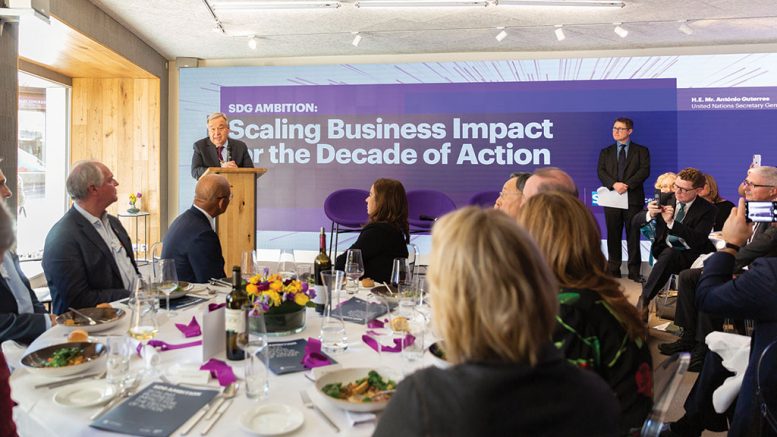A study of environmental, social and governance (ESG) practice in the mining sector that examined the top-50 listed mining companies by market capitalization and the world’s 20 largest institutional investors says much more work needs to be done to put ESG front and centre in the industry.
“Despite the compelling business case for ESG, and its acceptance as a critical issue by essentially all mining companies, there is no company that stands out as the undisputed leader in ESG performance,” concluded a report by Egon Zehnder, a global management consulting and executive search firm. “Even the world’s top mining companies still experience fatalities, spillages, community strife, conflict with non-governmental organizations and public relations disasters.”
The report entitled “From risk to reward: How a focus on ESG is transforming the mining industry,” noted that of the top-50 mining companies, less than half are signatories to the UN Global Compact Initiative — a voluntary initiative based on CEO commitments to implement universal sustainability principles. By contrast, 80% of the 20 largest institutional investors focused on the mining industry are signatories to the UN Principles for Responsible Investing (UNPRI).
Large investment firms like BlackRock and Vanguard “have made ESG a priority,” the report states, noting that the institutional investors who are signatories to the UNPRI jumped from 2,200 to 2,700 between March and November 2019.
“There has been one big shift from investors associating sustainable portfolios with a lower rate of return to a perception now that investing sustainably will give them higher rates of return,” Evy Hambro, chief information officer of natural resources and global head of thematic and sector investing at BlackRock, said in an interview with the report’s authors.
Sustainable investing — an investment approach that considers ESG factors — stood at US$30.7 trillion at the beginning of 2018, the report stated, a 34% increase in two years, according to the 2018 Global Sustainable Investment Review. The review is published by the Global Sustainable Investment Alliance, an international collaboration of membership-based sustainable investment organizations.
The rising popularity of ESG bonds or green bonds will continue to play an increasingly important role in debt financing, too. The report notes that BBVA, a Spanish multinational bank, has witnessed “exponential growth” in the issuance of ESG bonds.
Poor ESG performance can impact a mining company’s access to funds and its cost of capital, the report adds, particularly with the advent of third-party ESG rating indexes and agencies like MSCI and Sustainalytics. “We often see that companies with the worst ESG ratings are the ones with the most volatile stock price, and that is in itself a major risk for investors,” Sam Block, vice-president of ESG Research at MSCI, said in an interview published in the report.
Companies should also be aware that ESG is a focus for millennial retail investors, a group Egon Zehnder estimates hold as much as US$24 trillion of the world’s private wealth.
Coauthors Sameera Sandhu and Heloise Nel argue that it has only been in the last two to three years that ESG has come to the forefront of discussions in the mining sector.
“We feel that through a cross-section of the mining sector they are only just starting on ESG,” says Nel, who leads Egon Zehnder’s global mining and metals practice from South Africa.
The catalyst or watershed moment, they agree, was the Brumadinho tailings dam disaster at Vale’s Feijao iron ore mine in Brazil in January 2019 that killed 270 people, and the subsequent initiative by the Church of England Pensions Board and Sweden’s AP funds to write to nearly 700 listed mining companies requesting disclosure on their tailings facilities.
“With mining, the trigger point was Brumadinho, there wasn’t that much of a response from the investor community or otherwise in 2015 when the Samarco dam burst,” Sandhu, head of research for Egon Zehnder’s global mining and metals practice, said in an interview from New Delhi. “But with Brumadinho, investors stood up and said it really shouldn’t have happened. It came as a shock worldwide and then you had the Church of England stand up and put a spotlight on the industry.”
Mining companies must establish ESG as a priority from the top, they say.
“There needs to be a strong voice from the top — that’s the most powerful thing that any mining company can do,” Nel says in an interview from Johannesburg. “There’s still a lot of ground that can be covered.”
Among the report’s recommendations is to have mining CEOs “drive ESG across the company” and “be willing to sanction ‘bad’ behaviour rigorously and forfeit short-term profit for long-term sustainability.”
Boards should also have an ESG specialist that can “constructively challenge” the directors, CEO, and executive committee on all ESG matters and “help set the tone and culture of how the company views and addresses ESG issues,” the report states.
Egon Zehnder analyzed the board composition of the top-50 mining companies and found that less than 40% have at least one board member with a background focused on sustainability.
In an interview with the report’s authors, Michael Proulx, director of mining research at Sustainalytics, emphasized the key role boards must play in overseeing ESG risk.
“It is important that board members have sufficient understanding of ESG in order to identify where within the organization related risks exist,” he said, citing the example of BP and the Deepwater Horizon disaster, which resulted in over US$60 billion in claims, fees and charges for the company. “This led to a mass liquidation of assets (exceeding US$30 billion) and drastically changed the way the company is structured to meet the new operating environment. As an investor, this is what you are potentially concerned about.”
Proulx also said companies may need to restructure to avoid conflicts of interest, such as separating the compliance and legal departments.
“The Dodd-Frank Act exposed such a structure as a ‘conflict of interest.’ You have to separate the portion of the company that owns the risk (on the operational side), from the part of the company responsible for managing that risk,” Proulx explained in the report. “Compliance owns the risk, whereas legal manages it, so you cannot have one reporting to the other. That’s what contributed to the downfall of U.S. banks during the subprime crisis, yet it is a structure that remains prevalent in mining.”
Among its other recommendations, the report advises that chief financial officers play a greater role in ESG practice and become key champions “in measuring not only risk avoidance but also how the company is living up to its ESG promises in a very practical way.”
The report pointed to a “growing body of data” that shows companies incorporating sustainability practices do better than their peers.
“In one study, Harvard Business School research found a US$1 investment over 20 years yielded US$28 in return in those companies focused on ESG, versus US$14 for those without the focus,” the report said of the 2015 study. “In another study, ‘Cracking the ESG code’ by Scandinavian bank Nordea, the relative performance between the highest and the lowest ESG-rated companies that were analyzed differed by as much as 40% during the period 2012–2015.”
One positive example of ESG in the industry, the report says, was BHP CEO Andrew Mackenzie’s decision in July 2019 to invest US$400 million over five years to address climate change through low carbon technologies.
“That public commitment on climate action really helped get them across the line with some people, so it really makes a difference when you take a decision to elevate sustainability to the top rungs of your leadership,” Sandhu says.
“On the surface, the mining industry may seem like the least likely player to be a leader in ESG, but the reality is that no other industry is better positioned to create real, lasting change,” the report concludes. “Moving ESG to a company’s core will not be an easy process that is implemented overnight. But mining companies that choose to prioritize ESG will be the ones that both cultivate and reap the benefits.”





Be the first to comment on "Report: Miners have long way to go on ESG"